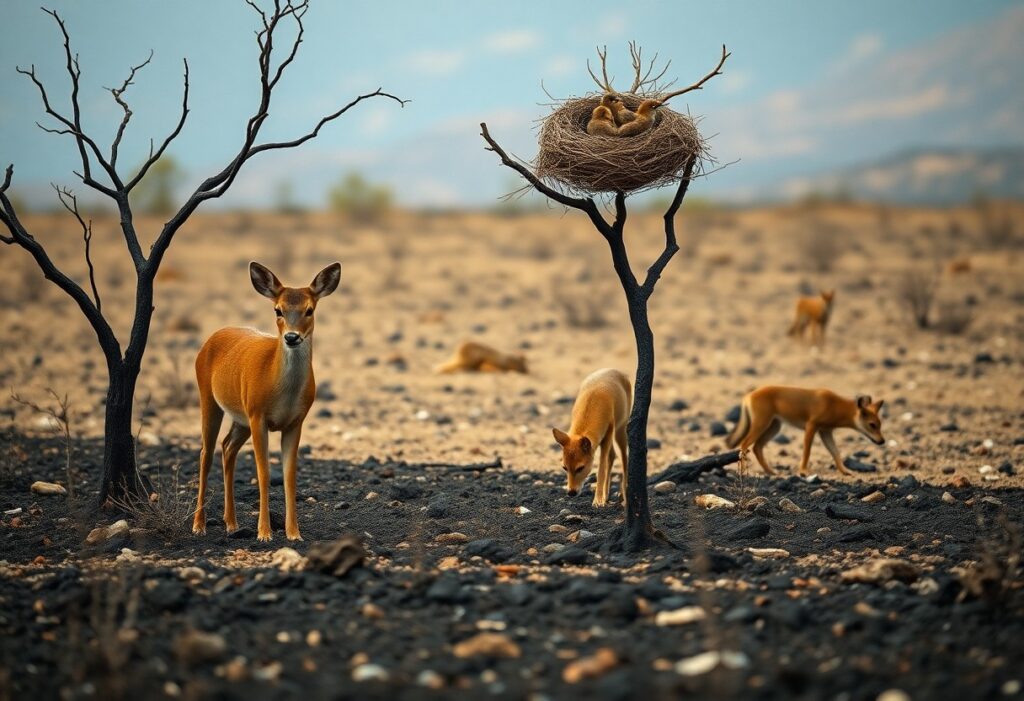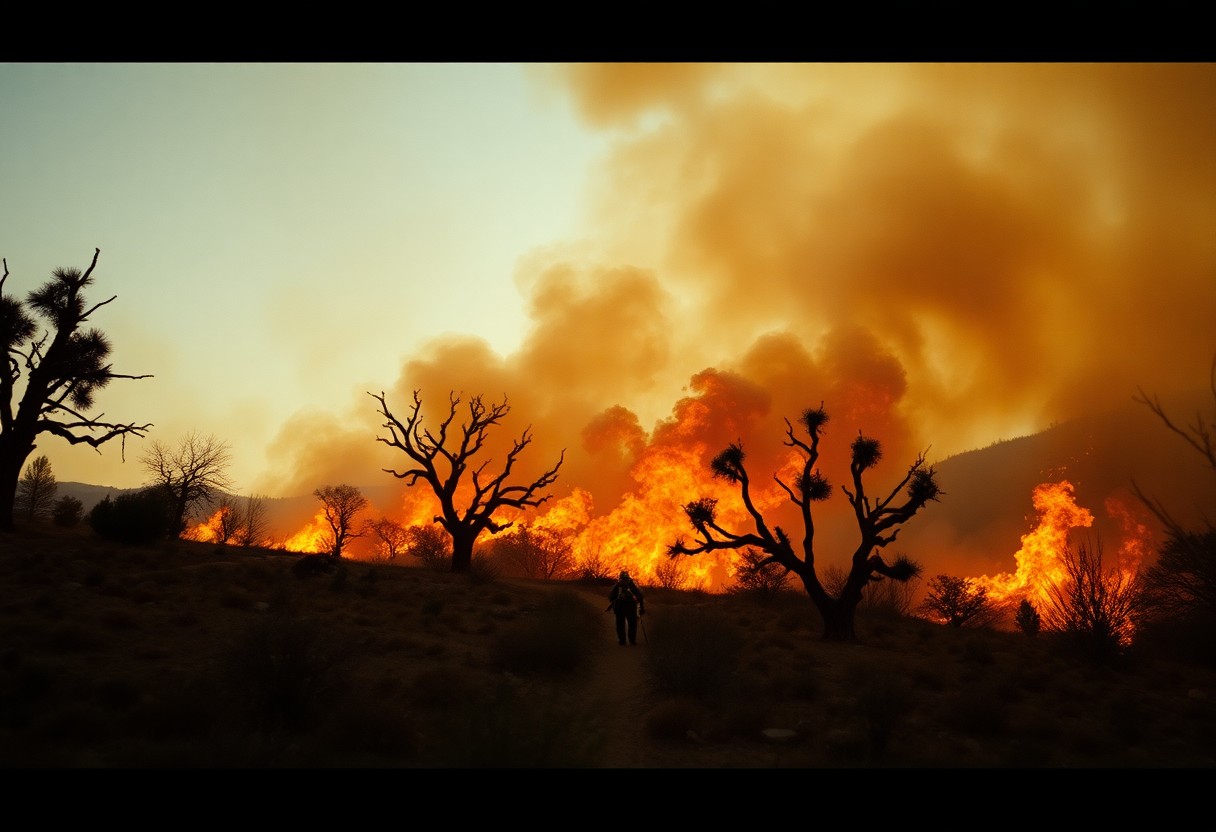Wildfires significantly alter the landscape of Los Angeles, affecting both flora and fauna in profound ways. You may not realize how these natural disasters impact wildlife habitats, forcing animals to flee and disrupting their breeding cycles. However, some species may benefit from post-fire regeneration, leading to changes in population dynamics. Understanding these effects is vital for conserving the diverse ecosystems within the region and protecting your local wildlife. Join us as we explore the intricate relationship between wildfires and wildlife in Los Angeles.
Overview of Wildfires in Los Angeles
Your understanding of wildfires in Los Angeles is crucial, given the region’s unique climate and landscape. With a Mediterranean climate characterized by wet winters and dry summers, Los Angeles is particularly vulnerable to wildfires, especially in areas with dense vegetation. These fires can have devastating effects on both property and wildlife, making it imperative to be aware of their patterns and causes.
Frequency and Causes
On average, wildfires in Los Angeles occur annually, exacerbated by a combination of factors such as drought conditions, high temperatures, and strong winds, particularly the Santa Ana winds. Human activities, including construction, campfires, and arson, also significantly contribute to the frequency of these fires.
Historical Context
With a long history of wildfires, Los Angeles has experienced several devastating events that shaped its landscape and wildlife. The Angeles National Forest Fire in 2009 and the Woolsey Fire in 2018 are just two examples that illustrate the growing threat of wildfires in this area. Understanding the patterns and trends of these historical fires is vital as it can inform future management strategies and help mitigate risks.
Understanding the historical context of wildfires in Los Angeles involves examining how civilization and natural ecosystems have interacted over time. Over centuries, wildfires have been both a natural phenomenon that shapes the ecology of the region and a major challenge for urban development. The frequency and intensity of wildfires have increased due to climate change, leading to more profound implications for wildlife and their habitats. By looking back at past fires, you can gain insights into how to better prepare for future events.
Habitat Loss and Fragmentation
While wildfires can rejuvenate certain landscapes, they also lead to significant habitat loss and fragmentation. In Los Angeles, you may notice that the once interconnected ecosystems become isolated pockets, limiting wildlife’s movement and their chances for survival. As urban sprawl combines with wildfire events, it creates barriers that inhibit breeding and access to vital resources, putting immense pressure on the local wildlife.”
Impact on Ecosystems
Beside habitat loss, wildfires greatly disrupt ecosystem balance. Your local flora and fauna are interdependent, and when one aspect is affected, it can have cascading effects on the entire ecosystem. Fire can alter soil composition and nutrient cycles, making it challenging for native plant species to recover, thereby impacting the entire food chain.
Challenges for Species Survival
With the increasing frequency of wildfires, your local wildlife faces unprecedented challenges. These habitat changes not only threaten animal populations but also hinder their ability to adapt to new environments. In particular, species already facing declines due to urbanization are at higher risk, as their survival rates drop when they can’t find suitable habitats or food sources.
Ecosystems are intricately linked, meaning that when one species faces survival challenges, it can lead to a domino effect on others. Lost habitats reduce biodiversity, making it harder for species to find mates or adequate shelter. The resulting decrease in genetic diversity can leave populations more vulnerable to diseases and environmental changes. Understanding these dynamics is vital for your awareness of how wildfires impact wildlife in Los Angeles.
Effects on Wildlife Behavior
Some of the most significant changes in wildlife behavior following wildfires are related to their movement and interaction patterns. Animals may exhibit altered daily routines, exhibiting stress and anxiety in their behavior as they navigate the aftermath of destruction. Your local wildlife, from birds to mammals, often becomes more secretive or even aggressive as they try to cope with the increased competition for resources and the loss of habitat.
Displacement and Migration
Wildlife often finds itself forced to adapt or relocate due to the destruction of their natural habitats caused by wildfires. Many species will migrate to safer areas, seeking refuge in environments that provide the necessary resources for survival. This movement can disrupt ecosystems, as the balance between species is altered and competition for food and shelter intensifies.
Changes in Feeding and Breeding
On the other hand, wildfires can lead to significant disruptions in feeding and breeding habits. Species that depend on specific flora for food may struggle to find sustenance, causing shifts in their dietary patterns. This can result in lower reproductive rates as fewer resources lead to stress and diminished health among the affected wildlife populations.
Even in the aftermath of wildfires, wildlife will adapt their feeding and breeding strategies to survive. In some cases, new growth from the burned area can provide a boost in food resources, allowing certain animals to thrive. However, the challenge remains, as many species face increased competition for these limited resources, leading to shifts in breeding cycles and further impacting overall population dynamics. Understanding these changes is important for conservation efforts aimed at supporting wildlife recovery during these challenging times.
Species at Risk
All wildfires pose a significant threat to various species inhabiting the Los Angeles area. These fires disrupt ecosystems, destroy habitats, and can lead to the declining populations of both common and rare wildlife. The struggle for survival becomes even more critical for species that are already vulnerable due to environmental changes and human impacts.
Endangered and Vulnerable Species
By understanding the challenges faced by endangered and vulnerable species, you can appreciate the urgent need for protective measures. Species such as the California condor and the coast live oak are at high risk, with populations dwindling as wildfires destroy their habitats. These creatures and plants need your advocacy to ensure their preservation.
Case Studies of Affected Species
Between 2016 and 2022, several species were notably impacted by wildfires in Los Angeles. Your awareness of these data points can highlight the urgency of protecting wildlife. Here are some case studies that illustrate the extent of this issue:
- California condor: Population reduced from 27 individuals in 1987 to 504 in 2021; wildfires of 2020 impacted nesting sites.
- Western toad: Estimated 40% decline in populations post-2017 fires due to loss of breeding habitats.
- Santa Ana Mountains’ mule deer: 30% population decrease recorded after the devastating 2018 wildfire season.
- San Francisco gopher snake: Habitat destruction led to a 25% decline in sightings following fire activity in 2019.
Species diversity in Los Angeles is heavily affected by the increasing intensity and frequency of wildfires. The above case studies exemplify the detrimental effects on both endangered and vulnerable species. The California condor’s precarious status reinforces the need for active fire management and conservation efforts. Additionally, personal initiatives, such as supporting local conservation programs, can help mitigate the impact wildfires have on these wildlife populations.
Recovery and Adaptation
After wildfires sweep through Los Angeles, the recovery and adaptation of wildlife is a testament to nature’s resilience. It may take time, but various species exhibit remarkable ability to rebound, utilizing the scorched earth as a catalyst for new growth. Through natural instincts, animals and plants begin to adapt to the altered landscape, finding new habitats and food sources, ultimately fostering a refreshed ecosystem.
Natural Recovery Processes
Before submerging into specific recovery strategies, it’s important to understand that ecosystems have inherent recovery processes. Fire can rejuvenate the landscape, allowing native plants to thrive and provide shelter and food for wildlife. This natural cycle promotes biodiversity, as different species of flora and fauna begin to recolonize the affected areas, creating a richer environment over time.
Role of Conservation Efforts
Around the affected regions, conservation efforts play a significant role in aiding wildlife recovery post-wildfire. Organizations and volunteers come together to restore habitats, support native species, and monitor the environment. Your involvement in these initiatives can lead to improved outcomes for wildlife, as resources are directed toward crucial areas and rehabilitation efforts gain momentum.
Due to your engagement and support of conservation efforts, numerous wildlife rehabilitation projects have been implemented to address the aftermath of wildfires. These initiatives focus on restoring habitats that are vital for numerous species to thrive. By implementing native plant restoration and managing invasive species, conservation teams actively work to ensure that wildlife adapts more effectively and efficiently. Your participation helps to provide vital funding and resources, ultimately reinforcing the habitats that animals rely upon for survival. This collective effort fosters a healthier ecosystem for future generations, ensuring that wildlife recovery continues long after the flames have subsided.
Community and Policy Responses
Despite the challenges posed by wildfires in Los Angeles, community and policy responses are vital in mitigating their effects on wildlife. Local organizations and government agencies are ramping up efforts to advocate for policies that protect ecosystems disrupted by fires. You can learn more about how the Los Angeles wildfires take toll on local wildlife and what is being done to help.
Wildlife Management Strategies
Across Los Angeles, wildlife management strategies are being implemented to address the aftermath of wildfires. These strategies include habitat restoration, wildlife relocation, and monitoring of affected species. By working closely with ecologists and conservationists, local authorities strive to develop plans that can help rehabilitate the impacted wildlife populations.
Community Awareness and Involvement
Around the region, community awareness and involvement play significant roles in wildfire response efforts. Engaging residents through educational programs fosters an understanding of the risks associated with wildfires and the importance of preserving local wildlife.
At the heart of community awareness is the need for you to stay informed about active fire threats and their impact on wildlife. Participating in local workshops and volunteer opportunities can enhance your understanding of the situation and boost your ability to assist recovery efforts. Your engagement helps raise awareness among others, ultimately creating a network of informed citizens dedicated to protecting our natural environment from the adverse effects of wildfires. By staying connected with local conservation groups, you can contribute to a more resilient ecosystem in and around Los Angeles.
Final Words
Ultimately, understanding the impact of wildfires on wildlife in Los Angeles allows you to appreciate the delicate balance of the ecosystem. You can take actionable steps to support conservation efforts and help rehabilitate affected species. By staying informed, advocating for responsible land management practices, and participating in community initiatives, you play a vital role in mitigating the devastating consequences these fires have on the rich biodiversity in your area. Your awareness and involvement can foster a healthier environment for both wildlife and future generations.










